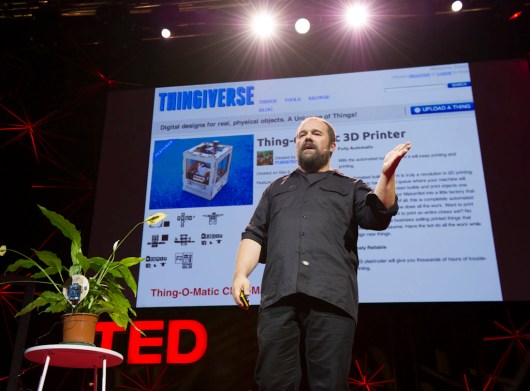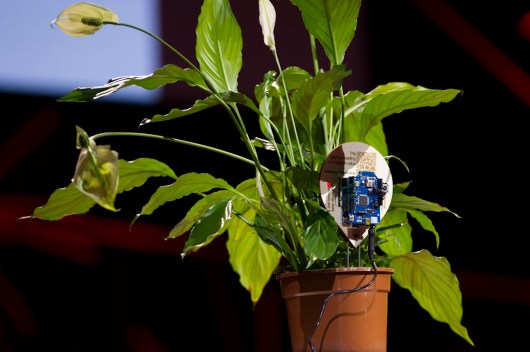Massimo Banzi is the co-founder of the Arduino project. An interaction designer and an educator, the spirited Italian bounds onto the stage to tell us a story. “A few weeks ago, a friend gave a toy car to his 8-year-old son,” he says. “But instead of going to buy one, he went to a website, he downloaded a file and he printed it using a 3D printer. Such digital fabrication was defined by The Economist as the third industrial revolution.” Banzi, however, would argue that this is instead the era of the makers.
Open source is at the heart of this movement, as is Arduino, the company Banzi founded with five friends while teaching at design school in Italy. They needed to help students be able to test their interaction designs quickly. After all, students don’t have years to build out their designs, they have only a few months. So they started to work on developing Arduino, a single-board microcontroller and a software suite for programming it.
The rest of the talk involves a whistlestop tour through some wonderful Arduino projects. First up is a project that was designed by a man who had two cats. One was sick, and he needed to make sure it ate its special food. So he equipped both cats with chips on their collars to open up the right bowl of feed. Low-tech? Yes. Effective? Yes.
[vimeo http://www.vimeo.com/10896151 w=400&h=300]
They designed Arduino, he says, to be open source and available so that other people could build on top of it. The hardware was released through a Creative Commons license; the software was open source. “It’s a mashup of open-source technologies,” he says. “The only thing that is protected is the brand.”
And now companies have taken the idea and are running with it. Banzi shows some of the makers who have adopted the thinking to create the “turbo-charged maker community” captured by Make magazine and websites such as instructables.com.
More examples: Matternet uses “arducopters” to create a new paradigm for transportation. Matt Richardson made the “Enough Already” project, which allows him to analyze which celebrities come on TV — and selectively mute them.
[youtube http://www.youtube.com/watch?v=-SzB5OQUcOU&w=560&h=315%5D
Arduinos are also being used in the Large Hadron Collider at CERN. And it’s the basis of Otto, a musical interface built by a student from Italy, which will now become a commercial project:
[youtube http://www.youtube.com/watch?v=9OW5WF5lJG8&w=560&h=315%5D
There’s a sign-language glove that can translate language. Students from ITP at NYU hacked a PS3 controller to help a boy with severe disabilities play games. Then there’s the TxtBomber, which can write political messages in graffiti. (This one gets hoots of applause from the audience.)
Now Banzi shows us the plant next to him onstage, which it turns out isn’t merely for decoration. Botanicalls plants tweet to let you know if they need to be watered or fed (the creator of this project, Kate Hartman, gave a TEDTalk). Kickbee detects a baby’s kick in the stomach of a pregnant woman — and tweets each time. Then there’s the 14-year-old boy in Chile who created Alerta de Sismos to tweet on detecting earthquakes.
Yet more projects — the Magic Clock, which analyzes a twitter feed to determine where in the world a family was — and represent on a clock. Or, of course, the chair that tweets when you fart.
This next one really is a serious project: the Tokyo Hackerspace/RDTN Geiger shield was developed after the nuclear accident at Fukushima to use Arduino to create a Geiger counter and share data online. Compubots were robots created by two kids. (In fact, when Banzi and Co. wanted to make robots, they simply asked the kids to help out. “I’m old. What do I know about making robots?” he asks.)
Big companies can learn from Arduino too. Google ADK uses Arduino. “Apple is closed-source, NDA, sign your life to Apple,” Banzi says scornfully. In this instance, a tilt maze is controlled by Arduino.
“It would take me seven hours to go through all the examples,” Banzi says, who describes the famous Pebble watch, also built on Arduino. Its makers advertised on Kickstarter for $100,000 in startup funds; they got $10 million. The equation is simple: “Just excited people with a great project.”
The final project in this lightning-fast demonstration of cool is ArduSat, a satellite with Arduino connected to sensors. “Anyone who knows Arduino can upload their experiments to an actual satellite,” he says happily. “Imagine being a student and being able to upload your experiments to space!”
Photos: James Duncan Davidson


Comments (12)
Pingback: UDOO Neo: an introduction to the next Tizen-powered board - IoT Gadgets
Pingback: UDOO Neo: an introduction to the next Tizen-powered board - Tizen Experts
Pingback: Creative Toppings | Arduino and prototypes – designing interactions [#isa2012]
Pingback: What if you could make anything you wanted?
Pingback: Open Source Hardware! Build your own design you can touch and interact « Building systems that WORK
Pingback: Massimo Banzi - TEDGlobal 2012 Talk | Lega Nerd
Pingback: The magic of a group think: TEDGlobal 2012 Day 1 recap « Content Curated By Darin R. McClure & a few photos
Pingback: TED Blog | Open-source your projects — and upload them to space: Massimo Banzi at TEDGlobal 2012 | Wiznet Weblog
Pingback: atomia-site-title